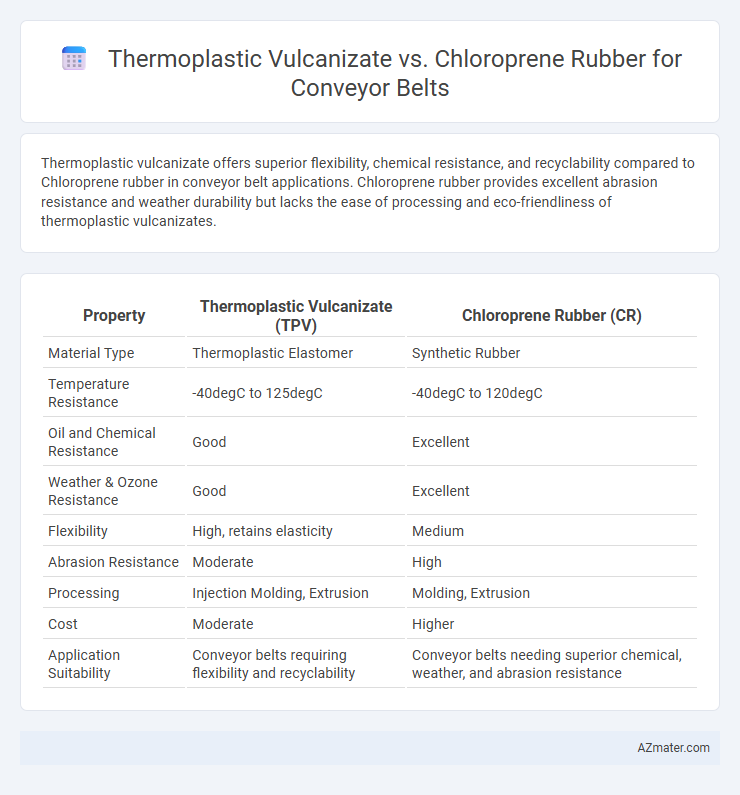Thermoplastic vulcanizate offers superior flexibility, chemical resistance, and recyclability compared to Chloroprene rubber in conveyor belt applications. Chloroprene rubber provides excellent abrasion resistance and weather durability but lacks the ease of processing and eco-friendliness of thermoplastic vulcanizates.
Table of Comparison
| Property | Thermoplastic Vulcanizate (TPV) | Chloroprene Rubber (CR) |
|---|---|---|
| Material Type | Thermoplastic Elastomer | Synthetic Rubber |
| Temperature Resistance | -40degC to 125degC | -40degC to 120degC |
| Oil and Chemical Resistance | Good | Excellent |
| Weather & Ozone Resistance | Good | Excellent |
| Flexibility | High, retains elasticity | Medium |
| Abrasion Resistance | Moderate | High |
| Processing | Injection Molding, Extrusion | Molding, Extrusion |
| Cost | Moderate | Higher |
| Application Suitability | Conveyor belts requiring flexibility and recyclability | Conveyor belts needing superior chemical, weather, and abrasion resistance |
Introduction to Conveyor Belt Materials
Thermoplastic vulcanizate (TPV) and chloroprene rubber (CR) are key materials used in conveyor belt manufacturing, each offering distinct mechanical and chemical properties. TPV provides excellent flexibility, chemical resistance, and temperature stability, making it suitable for dynamic conveyor applications with frequent flexing. Chloroprene rubber delivers superior abrasion resistance and durability, ideal for heavy-duty conveyor belts exposed to harsh environments and abrasive materials.
Overview of Thermoplastic Vulcanizate (TPV)
Thermoplastic Vulcanizate (TPV) is a high-performance elastomer combining the flexibility of rubber with the processing ease of thermoplastics, making it highly suitable for conveyor belt applications requiring durability and chemical resistance. TPV exhibits excellent elasticity, fatigue resistance, and thermal stability, outperforming Chloroprene rubber (Neoprene) in abrasion resistance and long-term mechanical properties under dynamic stress. Its superior processability enables efficient manufacturing of conveyor belts with enhanced lifespan and reduced maintenance costs in industrial environments.
Key Properties of Chloroprene Rubber (CR)
Chloroprene rubber (CR) offers excellent resistance to weathering, ozone, and oil, making it highly suitable for conveyor belt applications that require durability in harsh environments. Its inherent flexibility and good tensile strength provide reliable performance under mechanical stress and bending. The material's superior chemical resistance and flame retardancy further enhance the operational safety and longevity of conveyor belts in industrial settings.
Mechanical Strength Comparison: TPV vs CR
Thermoplastic vulcanizate (TPV) exhibits superior mechanical strength compared to chloroprene rubber (CR) in conveyor belt applications, offering enhanced tensile strength and abrasion resistance. TPV's dynamic vulcanized structure provides better flexibility and impact resistance under continuous stress, resulting in longer service life. In contrast, CR offers good resilience but generally falls short in durability and mechanical load capacity compared to TPV.
Chemical Resistance in Conveyor Applications
Thermoplastic vulcanizate (TPV) offers superior chemical resistance compared to chloroprene rubber in conveyor belt applications, effectively withstanding oils, solvents, and acids commonly encountered in industrial environments. TPV maintains its structural integrity and flexibility under prolonged exposure to harsh chemicals, reducing downtime and maintenance costs. Chloroprene rubber provides moderate chemical resistance but may degrade faster when exposed to aggressive chemicals, limiting its use in highly corrosive conveyor settings.
Temperature Resistance and Durability
Thermoplastic vulcanizate (TPV) offers superior temperature resistance, typically withstanding continuous exposure up to 135degC, making it suitable for conveyor belts in moderate heat environments. Chloroprene rubber (CR) excels in durability, providing exceptional resistance to abrasion, weathering, and chemicals, which extends conveyor belt lifespan in harsh industrial conditions. While TPV combines elasticity with thermoplastic processing advantages, chloroprene's robust molecular structure ensures reliable performance under extreme mechanical stress and variable temperatures.
Flexibility and Wear Performance
Thermoplastic vulcanizate (TPV) exhibits superior flexibility and excellent elastic recovery, making it well-suited for conveyor belts requiring frequent bending and dynamic movement. Chloroprene rubber (CR) offers robust wear resistance and good abrasion performance, ensuring durability under heavy load and rough surface conditions. TPV's combination of flexibility and moderate wear resistance contrasts with CR's harder, more abrasion-resistant nature, influencing the choice based on conveyor operational demands.
Cost Considerations and Lifecycle Value
Thermoplastic vulcanizate (TPV) typically offers a lower initial cost compared to chloroprene rubber, making it an economical choice for conveyor belts in budget-sensitive applications. TPV provides enhanced resistance to chemicals and UV exposure, translating into a longer service life and reduced maintenance expenses, which improves overall lifecycle value. Chloroprene rubber, while often more expensive upfront, delivers superior abrasion resistance and mechanical strength, potentially lowering replacement frequency and total cost of ownership in heavy-duty environments.
Environmental Impact and Sustainability
Thermoplastic vulcanizate (TPV) offers enhanced environmental sustainability for conveyor belts due to its recyclability and reduced energy consumption during manufacturing compared to chloroprene rubber, which is derived from non-renewable petrochemicals and involves chlorine-based processes with higher emissions. TPV materials typically exhibit longer lifecycle durability, reducing waste and the frequency of belt replacements, whereas chloroprene rubber's degradation products can pose ecological hazards. The lower carbon footprint and potential for circular economy integration position TPV as a more eco-friendly alternative in conveyor belt applications.
Choosing the Right Material for Conveyor Belts
Thermoplastic vulcanizate (TPV) offers superior flexibility, chemical resistance, and easier recyclability compared to chloroprene rubber, making it ideal for conveyor belts exposed to dynamic stress and chemical environments. Chloroprene rubber excels in abrasion resistance and weather durability, suitable for heavy-duty conveyor belts in harsh outdoor conditions. Selecting the right material depends on balancing flexibility, environmental resistance, and lifespan requirements specific to the conveyor belt's operational conditions.

Infographic: Thermoplastic vulcanizate vs Chloroprene rubber for Conveyor belt
 azmater.com
azmater.com